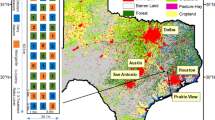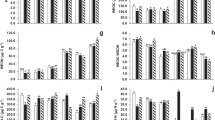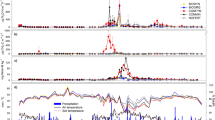Abstract
A field experiment was conducted to investigate the impacts of animal excrement-derived organic soil amendments on N2O, CH4, and heterotrophic CO2 emissions and net soil-associated greenhouse gas balances under an Italian ryegrass and forage corn double-cropping system on an Andosol in southwestern Japan. The experiment consisted of five treatments with three replicates: no nitrogen, chemical fertilizer (CF), composted dairy cattle manure (CCM), dairy slurry (DS), and digestate from biogas production (DBP). There were no significant differences in cumulative soil N2O emissions over three years among the CF, CCM, DS, and DBP treatments. Although N2O emission factors (a percent ratio of N2O-N emitted to N applied) were all quite low, the factor for composted dairy cattle manure (0.00 ± 0.02%) was significantly lower than that for chemical fertilizer (0.06 ± 0.01%). The soil was a net CH4 sink, and there were no significant differences in cumulative CH4 emissions among the five treatments. Soil CO2 emissions (i.e., heterotrophic soil respiration) increased in proportion to the organic carbon inputs from organic soil amendments. For dairy slurry, which contains abundant labile organic carbon, the decomposition of organic carbon was more pronounced during the summer corn season than during the winter ryegrass season. The contributions of soil N2O and CH4 emissions to soil-associated net greenhouse gas balance were negligible on a CO2-equivalent basis. All five treatments acted as a net source of greenhouse gases, but the CCM and DS treatments mitigated greenhouse gas emissions to the atmosphere in comparison with the CF treatment.




Similar content being viewed by others
References
Akiyama H, Yan X, Yagi K (2006) Estimations of emission factors for fertilizer-induced direct N2O emissions from agricultural soils in Japan: Summary of available data. Soil Sci Plant Nutr 52:774–787
Amon B, Kryvoruchko V, Amon T, Zechmeister-Boltenstern S (2006) Methane, nitrous oxide and ammonia emissions during storage and after application of dairy cattle slurry and influence of slurry treatment. Agric Ecosyst Environ 112:153–162
Baral KR, Arthur E, Olesen JE, Petersen SO (2016) Predicting nitrous oxide emissions from manure properties and soil moisture: An incubation experiment. Soil Biol Biochem 97:112–120
Bai M, Flesch T, Trouvé R, Coates T, Butterly C, Bhatta B, Hill J, Chen D (2020) Gas emissions during cattle manure composting and stockpiling. J Environ Qual 49:228–235
Bolinder MA, Crotty F, Elsen A, Frac M, Kismányoky T, Lipiec J, Tits M, Tóth Z, Kätterer T (2020) The effect of crop residues, cover crops, manures and nitrogen fertilization on soil organic carbon changes in agroecosystems: a synthesis of reviews. Mitig Adapt Strateg Glob Change 25:929–952
Bracken CJ, Lanigan GJ, Richards KG et al (2021) Source partitioning using N2O isotopomers and soil WFPS to establish dominant N2O production pathways from different pasture sward compositions. Sci Total Environ. https://doi.org/10.1016/j.scitotenv.2021.146515
Butterbach-Bahl K, Baggs EM, Dannenmann M, Kiese R, Zechmeister-Boltenstern S (2013) Nitrous oxide emissions from soils: how well do we understand the processes and their controls? Phil Trans R Soc B. https://doi.org/10.1098/rstb.2013.0122
Cambareri G, Wagner-Riddle C, Drury C, Lauzon J, Salas W (2017) Anaerobically digested dairy manure as an alternative nitrogen source to mitigate nitrous oxide emissions in fall-fertilized corn. Can J Soil Sci 97:439–451
Clemens J, Huschka A (2001) The effect of biological oxygen demand for cattle slurry and soil moisture on nitrous oxide emissions. Nutr Cycl Agroecosyst 59:193–198
Dahlgren RA, Saigusa M, Ugolini FC (2004) The nature, properties and management of volcanic soils. Adv Agron 82:113–182
Gilson G, Ferrero F, Bava L, Borreani G, Dal Prà A, Pacchioli MT, Sandrucci A, Zucali M, Tabacco E (2020) Forage systems and sustainability of milk production: Feed efficiency, environmental impacts and soil carbon stocks. J Clean Prod. https://doi.org/10.1016/j.jclepro.2020.121012
Grigatti M, Girolamo GD, Chincarini R, Ciavatta C, Barbanti L (2011) Potential nitrogen mineralization, plant utilization efficiency and soil CO2 emissions following the addition of anaerobic digested slurries. Biomass Bioenergy 35:4619–4629
Hanson PJ, Edwards NT, Garten CT, Andrews JA (2000) Separating root and soil microbial contributions to soil respiration: a review of methods and observations. Biogeochemistry 48:115–146
Holly MA, Larson RA, Powell JM, Ruark MD, Aguirre-Villegas H (2017) Greenhouse gas and ammonia emissions from digested and separated dairy manure during storage and after land application. Agric Ecosyst Environ 239:410–419
IPCC (Intergovernmental Panel on Climate Change) (2006) Chapter 11. N2O emissions from managed soils, and CO2 emissions from lime and urea application. In: Klein CD et al. (eds) 2006 IPCC Guidelines for National Greenhouse Gas Inventories, Vol 4, Agriculture, Forestry and Other Land Use. the Institute for Global Environmental Strategies, Hayama, Japan https://www.ipcc-nggip.iges.or.jp/public/2006gl/pdf/4_Volume4/V4_11_Ch11_N2O&CO2.pdf
IPCC (Intergovernmental Panel on Climate Change) (2007) Climate change 2007: The physical science basis. Contribution of working group I to the fourth assessment report of the intergovernmental panel on climate change. Cambridge University Press, Cambridge, United Kingdom and New York, NY, USA
Junior CC, Cerri CEP, Pires AV, Cerri CC (2015) Net greenhouse gas emissions from manure management using anaerobic digestion technology in a beef cattle feedlot in Brazil. Sci Total Environ 505:1018–1025
Katayanagi N, Hatano R (2005) Spatial variability of greenhouse gas fluxes from soils of various land uses on a livestock farm in Southern Hokkaido, Japan. Phyton 45:309–318
Kitamura R, Sugiyama C, Yasuda K, Nagatake A, Yuan Y, Du J, Yamaki N, Taira K, Kawai M, Hatano R (2021) Effects of three types of organic fertilizers on greenhouse gas emissions in a grassland on Andosol in Southern Hokkaido, Japan. Front Sustain Food Syst. https://doi.org/10.3389/fsufs.2021.649613
Köster JR, Cárdenas LM, Bol R, Lewicka-Szczebak D, Senbayram M, Well R, Giesemann A, Dittert K (2015) Anaerobic digestates lower N2O emissions compared to cattle slurry by affecting rate and product stoichiometry of denitrification – An N2O isotopomer case study. Soil Biol Biochem 84:65–74
Kumamoto Prefecture (2013) Fertilizer recommendations 2013 for Kumamoto green agriculture. 3–7 Forage crops. https://www.pref.kumamoto.jp/soshiki/74/854.html (in Japanese)
Linn DM, Doran JW (1984) Effect of water-filled pore space on carbon dioxide and nitrous oxide production in tilled and nontilled soils. Soil Sci Soc Am J 48:1267–1272
Ma Q, Wen Y, Wang D, Sun X, Hill PW, Macdonald A, Chadwick DR, Wu L, Jones DL (2020) Farmyard manure applications stimulate soil carbon and nitrogen cycling by boosting microbial biomass rather than changing its community composition. Soil Biol Biochem. https://doi.org/10.1016/j.soilbio.2020.107760
Ministry of Agriculture, Forestry and Fisheries of Japan (2021) Results from the national survey on the treatments of animal feces in 2019. https://www.maff.go.jp/j/chikusan/kankyo/taisaku/pdf/H31_syori-joukyou.pdf (in Japanese)
Ministry of Agriculture, Forestry and Fisheries of Japan (2022) Circumstances of agricultural soils in Japan. https://www.maff.go.jp/j/seisan/kankyo/attach/pdf/tuchi_kanren-8.pdf (in Japanese)
Mori A (2021) Farmyard manure application and associated root proliferation improve the net greenhouse gas balance of Italian ryegrass – Maize double-cropping field in Nasu, Japan. Sci Total Environ. https://doi.org/10.1016/j.scitotenv.2021.148332
Mori A, Hojito M (2015) Effect of dairy manure type on the carbon balance of mowed grassland in Nasu, Japan: comparison between manure slurry plus synthetic fertilizer plots and farmyard manure plus synthetic fertilizer plots. Soil Sci Plant Nutr 61:736–746
Mukumbuta I, Shimizu M, Jin T, Nagatake A, Hata H, Kondo S, Kawai M, Hatano R (2017) Nitrous and nitric oxide emissions from a cornfield and managed grassland: 11 years of continuous measurement with manure and fertilizer applications, and land-use change. Soil Sci Plant Nutr. https://doi.org/10.1080/00380768.2017.1291265
Obara H, Ohkura T, Takata Y, Kohyama K, Maejima Y, Hamazaki T (2011) Comprehensive soil classification system of Japan First approximation. Bull Natl Inst Agro-Environ Sci 29:1–73 (in Japanese with English summary)
Qin Z, Deng S, Dunn J, Smith P, Sun W (2021) Animal waste use and implications to agricultural greenhouse gas emissions in the United States. Environ Res Lett. https://doi.org/10.1088/1748-9326/ac04d7
R Core Team (2021) R: A language and environment for statistical computing. R Foundation for Statistical Computing, Vienna, Austria. URL https://www.R-project.org/.
Saunders OE, Fortuna A, Harrison JH, Cogger CG, Whitefield E, Green T (2012) Gaseous nitrogen and bacterial responses to raw and digested dairy manure applications in incubated soils. Environ Sci Technol 46:11684–11692
Shimizu M, Marutani S, Desyatkin AR, Jin T, Hata H, Hatano R (2009) The effect of manure application on carbon dynamics and budgets in a managed grassland of Southern Hokkaido, Japan Agric Ecosyst Environ 130:31–40
Thomas BW, Hao X (2017) Nitrous oxide emitted from soil receiving anaerobically digested solid cattle manure. J Environ Qual 46:741–750
Yamane T, Yamada I (2009) Nitrous oxide emission from cattle manure compost pellets applied to Andosols. Jpn J Soil Sci Plant Nutr 80:403–407 (in Japanese)
Zhou M, Zhu B, Wang S, Zhu X, Vereecken H, Brüggemann N (2017) Stimulation of N2O emission by manure application to agricultural soils may largely offset carbon benefits: a global meta-analysis. Glob Change Biol 23:4068–4083
Acknowledgements
The authors express special thanks to Ms. Keiko Morita, Ms. Keiko Furukawa, Ms. Mao Ueno, and Ms. Sayoko Hirayama for sampling and analysis of gas, soil, and plant samples. We are also indebted to Mr. Koichi Hatanaka, Mr. Yasushi Kiyomura, and Mr. Hiroyuki Ito from the Kyushu Okinawa Agricultural Research Center, NARO for their support in set-up and management of the experimental field. The advice and support provided by Dr. Shigeto Sudo from the Institute for Agro-Environmental Sciences, NARO was a great help in gas chromatography analysis. This work was financially supported by the Ministry of Agriculture, Forestry and Fisheries of Japan through a national research project entitled “Development of climate change mitigation technology in the livestock sector”.
Author information
Authors and Affiliations
Corresponding author
Ethics declarations
Conflict of interest
The authors declare no competing financial interests.
Additional information
Publisher's Note
Springer Nature remains neutral with regard to jurisdictional claims in published maps and institutional affiliations.
Supplementary Information
Below is the link to the electronic supplementary material.
Rights and permissions
About this article
Cite this article
Koga, N., Ihara, H., Yamane, T. et al. Soil greenhouse gas emissions from an animal excrement-based forage cropping system. Nutr Cycl Agroecosyst 123, 153–167 (2022). https://doi.org/10.1007/s10705-022-10214-4
Received:
Accepted:
Published:
Issue Date:
DOI: https://doi.org/10.1007/s10705-022-10214-4




